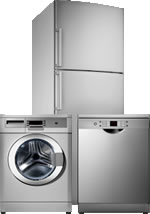How an Electric Range WorksWhether a range, stove or oven, the principle for heating and temperature control is the same. Electricity flows through an element which, because of electrical resistance, gives off heat. The more electricity applied, the more heat generated. The temperature control works like a dimmer to increase or decrease the flow of electricity. It is called an infinite switch because it is infinitely variable. A stove consists of several burners, usually four, each with an individually controlled heating element. The heating element is an electrical wire insulated by a nonconductive sheath. The heat passes through the sheath but electricity does not, that is why you don't get shocked when you touch a pot on the stove. When a problem occurs with a burner, it is usually a defective element, defective switch or a loose connection. They are very simple circuits and that makes them easy to repair. Smooth top cooking surfaces put a sheet of glass between the heating elements and the cookware. Some of these stoves feature instant heat surfaces in which the heating element is augmented by a halogen light. Some stoves use enclosed or ceramic elements to improve the look of the cook top. Those elements are functionally the same standard elements except they are encased in ceramic material. An oven typically has a baking element and a broiling element. These two elements are controlled by an oven selector switch and/or a temperature control. They work in the same way as a stove's burner with the exception that a thermostat monitors the temperature and opens the circuit when the temperature reaches the limit set on the temperature control. When the temperature drops to a preset point, roughly 20 degrees, the circuit is closed and the element heats up again. An oven's inner shell is typically enameled steel. Outside of the shell is a layer of insulation to prevent the high temperatures generated in the oven from being transmitted to its outer surface. Ovens use a clock and timer to aid in cooking and to control features such as the self-cleaning mechanism. Many ovens have an interior light, which may go on when the door is opened and/or manually via a switch. Convection ovens are just an oven with a fan inside, it's that simple. But the fan significantly improves the function of the oven. The circulation of the air inside the oven results in faster, more even baking. A self-cleaning oven burns off the residue in the oven by heating up to roughly 700 degrees. A timer turns off the heat but usually will not allow the door to be unlatched until the temperature has dropped to a safe level. Never attempt to open an oven during a self-cleaning cycle or before it has sufficiently cooled down. For the self-cleaning feature to work, the door must be latched closed. |
 |
|




